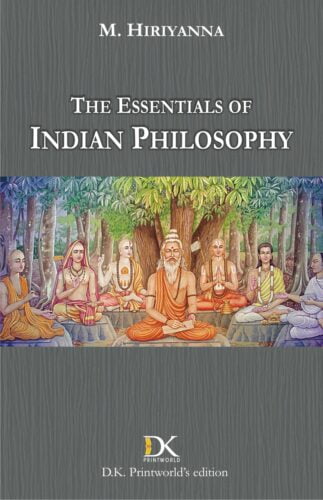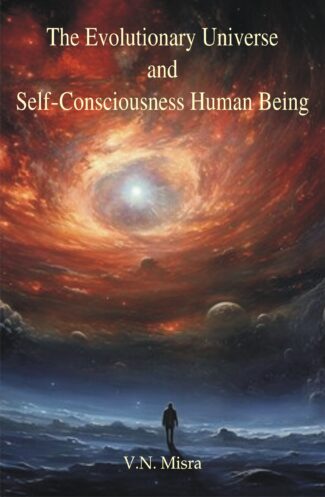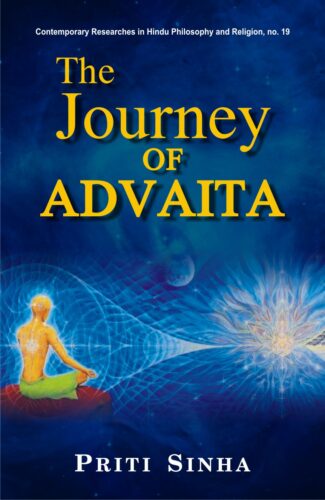Showing 231–240 of 292 results

This book is an excellent exposition of the complex philosophy of Advaita. A special feature of the book is that it inspires the readers to inquire deeply into their own traditions and undertake the mystical quest.
Written with extraordinary clarity and elegance, this book is an excellent exposition of the complex philosophy of Advaita. A special feature of the book is that it inspires the readers to inquire deeply into their own traditions and undertake the mystical quest. The author’s emphasis on first-hand truth is indeed heartening, for, as he says quite rightly, ultimate questions are too important to be left for others to determine the answers. Professor Puligandla approaches Vedanta as a free and independent thinker with a desire to modernize its format and shows the key to search and reach the highest form of living truth by tracing the single theme of non-dualism.
Indisputably one of the world’s best-known books, the Bhagavadgita embodies the quint-essence of classical Upanisadic philosophy, presented in the form of a dialogue between Krsna, the archetypal teacher, and Arjuna, the archetypal human being caught in the grip of a monumental crisis. For anyone like Arjuna who has ever paused to ponder the meaning of life, the work is as relevant today as it was when it was written.
By stripping away the manifold biases — both subtle and obvious — that have colored other commentaries, Guru Nitya has uncovered the perennial philosophy at the heart of this great classic. In an original, easy to understand format, his commentary divides each of the Gita’s eighteen chapters into three sections: the first elucidating the basic concepts involved; the second including Sanskrit text in Roman script along with the English meaning of each word or phrase and Nataraja Guru’s lucid and revolutionary English translation; and the third carrying explanatory notes and comments in the form of a dialogue between a teacher and student.
The breakthrough of this interpretation of the Gita is in its transcendence of sectarian dogma to reveal the work as a fully developed scientific psychology, whose keen insights and vivid reasoning can be readily appreciated by the twenty-first-century mind.

This volume deliberates on the “essentials” of Indian philosophy allowing one to peruse, analyse and absorb its crux. It has set its focus on the history of Indian philosophy starting from the course of Vedic religion, its transition to the prominent systems, its intake from the non-Vedic schools of thought, and the details and analysis of NyÀya-VaieÈika, SÀÚkhya-Yoga, PÂrva-MÁmÀÚsÀ, and VedÀnta from both an absolutistic and a theistic approach.
As the title indicates, this volume deliberates on the essentials of Indian philosophy allowing one to peruse, analyse and absorb its crux. It has set its focus on the history of Indian philosophy starting from the course of Vedic religion, its transition to the prominent systems, its intake from the non-Vedic schools of thought, and the details and analysis of NyÀya-VaieÈika, SÀÚkhya-Yoga, PÂrva-MÁmÀÚsÀ, and VedÀnta from both an absolutistic and a theistic approach. The book portrays the authentic chronological limits of these systems, disagreeing many a theory and study. Its in-depth but concise and connecting account of Indian philosophical systems has vivid interpretations and daunting criticisms. A historical survey accompanies each natural division of the subject along with its theory of knowledge, ontology and practical teaching. It makes one grasp the fundamentals of Indian philosophy at ease and navigate further to its nuances across a vide spectrum of readers.

This volume deliberates on the “essentials” of Indian philosophy allowing one to peruse, analyse and absorb its crux. It has set its focus on the history of Indian philosophy starting from the course of Vedic religion, its transition to the prominent systems, its intake from the non-Vedic schools of thought, and the details and analysis of NyÀya-VaieÈika, SÀÚkhya-Yoga, PÂrva-MÁmÀÚsÀ, and VedÀnta from both an absolutistic and a theistic approach.
As the title indicates, this volume deliberates on the essentials of Indian philosophy allowing one to peruse, analyse and absorb its crux. It has set its focus on the history of Indian philosophy starting from the course of Vedic religion, its transition to the prominent systems, its intake from the non-Vedic schools of thought, and the details and analysis of NyÀya-VaieÈika, SÀÚkhya-Yoga, PÂrva-MÁmÀÚsÀ, and VedÀnta from both an absolutistic and a theistic approach. The book portrays the authentic chronological limits of these systems, disagreeing many a theory and study. Its in-depth but concise and connecting account of Indian philosophical systems has vivid interpretations and daunting criticisms. A historical survey accompanies each natural division of the subject along with its theory of knowledge, ontology and practical teaching. It makes one grasp the fundamentals of Indian philosophy at ease and navigate further to its nuances across a vide spectrum of readers.

The book elucidates scientifically and philosophically the evolutionary universe (brahmāṇḍa) and the self-conscious human being (piṇḍa). This universe came into form about 14-13.7 billion years ago and has undergone perpetual changes including life on earth some 3.9 billion years ago. Man’s self-conscious evolution is driven by his intellectual growth and philosophical wisdom.
The book elucidates scientifically and philosophically the beginning of the evolutionary universe (brahmāṇḍa) and the intellectual growth of self-conscious human being (piṇḍa), the former is “out” there and the latter is “out” here. Without the latter, the former is difficult to be perceived or known. Going by the scientific cosmology, this universe came into form about 14-13.7 billion years ago as a result of Big Bang, and has undergone perpetual changes including life on earth some 3.9 billion years ago. Man’s self-conscious evolution is driven by his intellectual growth and philosophical wisdom. It has been studied both from the Indian and Western philosophic perspectives.
The philosophical wisdom in this regard is in sync with many modern scientific concepts. The Sāṁkhya–Yoga philosophy is embodied with the concepts of sattva, rajas and tamas. These three are in a sense comparable to the proton, the electron and the neutron of modern science. The proton provides the coalescence or the form of the atom; the electron gives us energy and proton provides the mass. Some other Indian philosophical systems like Vaiśeṣika, Advaita Vedānta and Bauddha are replete with similar scientific approaches. So also are the studies of Western philosophers like Immanuel Kant, David Hume, Niels Bohr and David Bohm. All the things are happening within the time and space.

The Gospel of Buddha sketches the picture of a religious leader of the remote past with a view of make it bear upon the living present and become a factor in the formation of the future. It essentially talks about all major developments in the life of the Buddha and helps all true Buddhists understand the real tenets of Buddhism to stand firm on ground.
The Gospel of Buddha characterizes the spirit of Buddhism correctly and concisely. It draws parallelisms in Western thoughts, especially those which reflect in the Christian Gospels. Buddhism like Christianity has a number of sects and this book, however, does not side with any sectarian tenets, but takes an ideal position upon which all true Buddhists may stand up as on firm ground. It helps people to comprehend Buddhism better in an easy way and it sets the reader thinking on the problems and challenges of religions today.
It sketches the picture of a religious leader of the remote past with a view of make it bear upon the living present and become a factor in the formation of the future. It essentially talks about all major developments in the life of the Buddha – his transformation from Prince SiddhÀrtha to the Buddha, to his founding of the Kingdom of Righteousness, to the consolidation of his religion, to his teachings, and to the parables and stories that he used, to his last days.
This book is expected to serve both the Buddhists and Christians to penetrate deep into the spirit of their faith so as to see its full length, breadth and length.

The Gospel of Buddha sketches the picture of a religious leader of the remote past with a view of make it bear upon the living present and become a factor in the formation of the future. It essentially talks about all major developments in the life of the Buddha and helps all true Buddhists understand the real tenets of Buddhism to stand firm on ground.
The Gospel of Buddha characterizes the spirit of Buddhism correctly and concisely. It draws parallelisms in Western thoughts, especially those which reflect in the Christian Gospels. Buddhism like Christianity has a number of sects and this book, however, does not side with any sectarian tenets, but takes an ideal position upon which all true Buddhists may stand up as on firm ground. It helps people to comprehend Buddhism better in an easy way and it sets the reader thinking on the problems and challenges of religions today.
It sketches the picture of a religious leader of the remote past with a view of make it bear upon the living present and become a factor in the formation of the future. It essentially talks about all major developments in the life of the Buddha – his transformation from Prince SiddhÀrtha to the Buddha, to his founding of the Kingdom of Righteousness, to the consolidation of his religion, to his teachings, and to the parables and stories that he used, to his last days.
This book is expected to serve both the Buddhists and Christians to penetrate deep into the spirit of their faith so as to see its full length, breadth and length.

The Journey of Advaita elucidates the richness, depth and profundity of Advaitic thought right from the Vedas to the Integral Advaitism of Sri Aurobindo, and further how it is being incorporated in modern science. In its long journey, it found its blossom in Shankaras Kevaladvaita, and in its further growth, Bhakti-Vedanta played an important role through Ramanuja, Madhva, Nimbarka and Vallabha.
The Journey of Advaita elucidates the richness, depth and profundity of Advaitic thought right from Vedas to Integral Advaitism of Sri Aurobindo and further how it is being incorporated in modern science.
Advaita Philosophy is not a later development of thought as one of the six systems of Indian philosophy. Vedas are replete with suggestions about Unity. The earlier stage of naturalistic and anthropomorphic polytheism yielded to monistic belief. In the dictum, ekam sad vipra bahudha vadanti we perceive an echo of Unity. Upanishadic seers picked up this Unity and tirelessly went in their search till they came to the highest conclusion, tat tvam asi.
This concept of Unity gets its full bloom in Shankaras Kevaladvaita; later on it gave inspiration to different rivulets of Vedanta schools. Shankaras unqualified impersonal Brahman could not satisfy those who sought loving communion with God. Consequently different schools of Bhakti-Vedanta came into existence, namely, Vishishtadvaita of Ramanuja, Dvaita of Madhva, Dvaitadvaita of Nimbarka and Shuddhadvaita of Vallabha. For all of them the emphasis is on the liberation of individual soul only, which gave way to Sri Aurobindos Integral Advaitism where the emphasis is not only on spiritualization of man but of the whole cosmos.
The journey continues further with modern physics. Consciousness is the building block of the Universe and the ground of all beings, which cant be found in plural.

This book in three parts is unique as it depicts the life of this spiritual preceptor, chronologically detailing the varied roles he played to change the social, economic, political, religious and spiritual life of the people and the countless incredible miracles he performed during his 72 years of worldly existence.
The relevance and importance of the teachings of the saint-poet-philosopher-social reformer Sree Narayana Guru are increasing day by day and have been influencing millions of people all over the world. Of the hundreds of biographies of Guru, this book in three parts is unique as it depicts the life of this spiritual preceptor, chronologically detailing the varied roles he played to change the social, economic, political, religious and spiritual life of the people and the countless incredible miracles he performed during his 72 years of worldly existence.
The book provides an in-depth study of the social conditions prevailing in the nineteenth and twentieth centuries of Kerala. A picture is clearly drawn on how an avarna liberated a society steeped in ignorance to such heights that the higher-ups in social order could not even dream of, by a bloodless spiritual revolution. The different roles Guru enacted in his life and the numerous miracles he performed, not highlighted so far in any biography, find a prominent place in this book. The life of Guru is presented here as it was. Readers can form their own conclusions about this great soul. The Foreword by Prof. M.K. Sanoo is a window to enter into the insight of the life of the Guru.

It shows how reality is generated in a recursive fashion and uses this insight to illuminate many puzzles of history and culture. The book straddles history and science, aesthetics and religion, and politics and power, by juxtaposing material in ways that provide surprising new insights.
The Loom of Time shows how reality is generated in a recursive fashion and uses this insight to illuminate many puzzles of history and culture. Recursion is at basis of mimicry in nature and germination and development of biological organisms; it also provides structure to mental images of physical systems and human behavior. It helps us make sense of the repeating patterns across cultures and nations, understand the manner in which technology is impacting society, and see the reasons behind the crises of the contemporary world.
The topics covered in this book include philosophical bases of recursion, cosmologies old and new, religion and modernity, globalization and bureaucratic control, loss of meaning and freedom, spirituality, narcissism leading to despair, and limits of medicine. It deals with problems of employment and questions of meaning of life when robots and other machines become more numerous than humans. The book straddles history and science, aesthetics and religion, and politics and power, by juxtaposing material in ways that provide surprising new insights.
| There are no products |